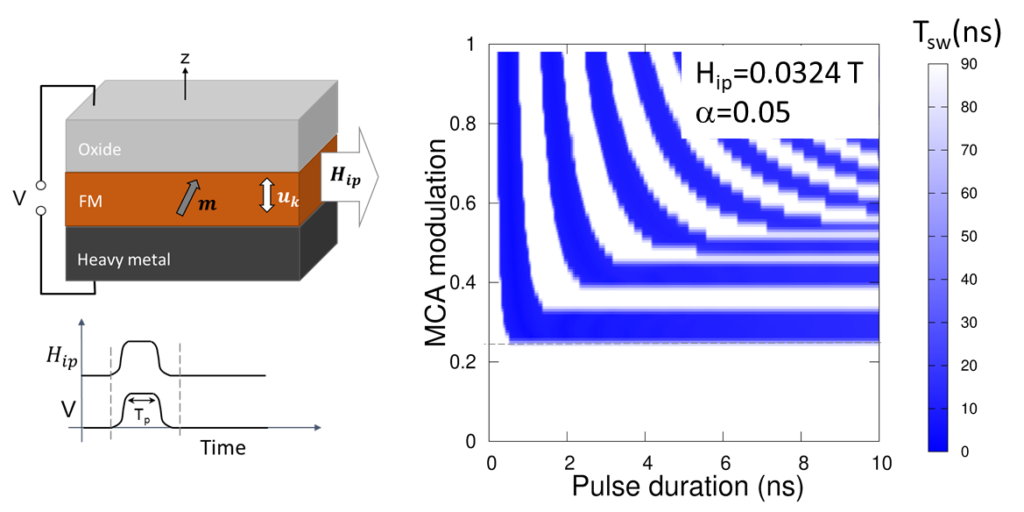Using a macrospin approach, we carried out a systematic analysis of the role of the voltage controlled magnetic anisotropy on the magnetization dynamics of nanostructures with out-of-plane magnetic anisotropy. Diagrams of the magnetization switching have been computed depending on the material and experiment parameters thus allowing predictive sets of parameters for optimum switching experiments.
Voltage controlled magnetic anisotropy (VCMA) became in the last ten years a subject of tremendous interest in the field of spintronics due to its promising potential outcomes: fast and low power consumption magnetization manipulation in magnetoresistive random access memories with enhanced storage density. To understand the role of the VCMA and find how to take benefit it, we performed macrospin simulations of the precessional magnetization switching assisted by a pulse gate voltage synchronous with a pulse external in-plane magnetic field.

Trilayer structure with gate controlled magnetic perpendicular anisotropy. An in-plane field is simultaneously applied with the gate voltage. The associated magnetization switching diagram depending on the pulse duration and the anisotropy modulation for a sample with enhanced damping.
Our simulations show that both the switching probability and the switching time depend strongly on the material and experiment parameters such as the surface anisotropy, Gilbert damping, duration/amplitude of electric and magnetic field pulses. Two characteristic times of the trajectory of the magnetization were analyzed analytically and numerically setting a lower limit for the duration of the pulses to achieve an optimal reversal. Following the conditions for the minimum electric field required to switch the magnetization, we demonstrate that a very interesting switching regime exits, where the fast precessional reversal does not anymore depend on the voltage pulse duration. This represents a promising path for the magnetization control by VCMA with enhanced versatility since it do not request the precise control of the pulse duration. Such regime can be tuned via specific magnetic material parameters such as the Gilbert damping.
Teams: Theory and Simulation, MRAM, Magnetic sensors
Collaboration: Babes-Bolyai University and Technical University (Cluj‑Napoca, Romania)
Funding: ERC Adv grant 669204 MAGICAL
Further reading: Route towards efficient magnetization reversal driven by voltage control of magnetic anisotropy, R. A. One, H. Béa, S. Mican, M. Joldos, P. Bradao Veiga, B. Dieny, L. D. Buda-Prejbeanu and C. Tiusan, Sci Rep 11, 8801 (2021).
Contacts: Liliana BUDA-PREJBEANU




